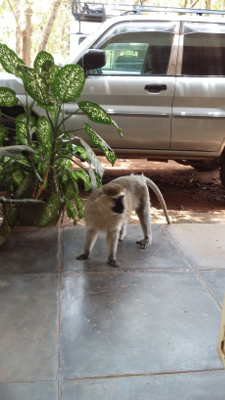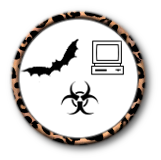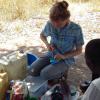Don’t miss Disease X!
Stay on top of the latest scientific literature on zoonotic virus discovery.
Keeping up with the ever-increasing list of new and emerging viral zoonoses can be challenging. Especially in the face of a current or recent outbreak, such as the Ebola, Zika, or Lassa epidemic, you will find plenty of publications on a certain pathogen. Spotting the truly new zoonotic threat in this vast amount of publications on infectious diseases can feel like trying to find a needle in a haystack. This new curated twitterbot and reference list are aiming for just that. Give it a go!

WHO's top ten list
In December 2015 a panel of scientists and public health experts convened by the World Health Organization (WHO) met in Geneva. Their task was to create a list of infectious diseases which need the most urgent attention by international research and development (R&D) efforts.
In order to prioritize, only five to ten diseases were to be included in the list. The criteria for the top diseases were
- that they have to be caused by highly dangerous emerging pathogens
- which are likely to cause severe outbreaks in the near future
- for which no or very limited medical countermeasures exist. [1]
The top priority list of that initial meeting consisted of the following eight diseases:
- Crimean-Congo haemorrhagic fever (CCHF) [3]
- Ebola virus disease [4]
- Marburg virus disease [5]
- Lassa fever [6]
- Middle East respiratory syndrome (MERS-CoV) [7]
- Severe Acute Respiratory Syndrome (SARS) [8]
- Nipah [9]
- Rift Valley fever [10]
The following three diseases were ranked as “serious”:
The annual review in February 2018 [2] approved the initial list with the following amendments:
- Nipah was accompanied by other henipaviral diseases.
- Zika was promoted from the “serious” diseases to the top priority list.
- Disease X was included.
The term Disease X refers to an unidentified new pathogen. This “wild-card” disease agent is not known to cause disease in humans today but has the potential to cause a serious international epidemic in future.
As in 2015, the experts of the 2018 meeting also considered
- Chikungunya
- Severe fever with thrombocytopaenia syndrome (SFTS)
as needing special attention by R&D efforts.
In addition, they included the following diseases as also very important:
- Arenaviral hemorrhagic fevers other than Lassa Fever
- Highly pathogenic coronaviral diseases other than MERS and SARS
- Emergent non-polio enteroviruses (including EV71, D68). [14]
Although not included in the top or high priority list, monkeypox [15] and leptospirosis [16] were also discussed at the 2018 follow-up WHO meeting.
In addition, there are more severe diseases which pose global public health threats, such as dengue, yellow fever, HIV/AIDs, tuberculosis, malaria, influenza, smallpox, cholera, leishmaniasis, West Nile Virus, and plague. However, for these diseases, established prevention and control policies as well as research networks are in place.
If you go through the above mentioned diseases, they all share a zoonotic background and/or are vector-borne. Because of this, WHO favors a so-called One Health approach in tackling these challenges.
It stands out that all of the top and high priority list pathogens are viruses. However, the meeting report of the 2018 annual review [17] points out that any type of pathogen could be prioritized under the WHO R&D Blueprint, not only viruses.
This guideline considers the possibility that, for example, multidrug-resistant bacteria could emerge, and then would come to the fore. Antimicrobial resistance of bacteria and parasites is a rising global concern [18]. However, this issue is addressed through other specific international initiatives.
Overall, against the background of the recent WHO R&D Blueprint Meeting 2018, it is a safe bet to assume that the next pandemic alias Disease X will be caused by a zoonotic virus.
Curated Twitterbot and Reference List on Zoonotic Virus Discovery
Therefore, I decided to compile a collection of recent publications and preprints on the discovery of (potentially) zoonotic novel virus species. Studies which found new strains of known virus species are also included, if the determined genotype is significantly different or postulated to pose new zoonotic risks.
The list is constantly being updated as an automated but curated twitterbot [19], alerting you, when a relevant research article has been released. Papers and preprints are only included, if at least a major part of the genome of the respective novel virus species or strain will be publicly available. Sources for this feed are PubMed, bioRxiv, PeerJ, and F1000.
In addition to this “real-time” literature update on the social media channel Twitter, you can find a growing list of recent papers, preprints and book chapters on this site. Apart from the above mentioned sources, also relevant results from GoogleScholar are included.
The launch of this literature collection on zoonotic virus discovery starts with all articles found in reverse chronological order since the beginning of the year 2018. It will be continued by compiling more and more research findings from the recent past.
While this list is intended to give you a comprehensive overview of the field, it can by no means make a claim to be complete. So you are cordially invited to comment on papers which you think should be added.
References
[1] WHO Blueprint for R&D preparedness. Dec 2015. Geneva.
[2] WHO Blueprint for R&D preparedness. Second annual review. Feb 2018. Geneva.
[3] WHO Fact sheet N°208. Crimean-Congo haemorrhagic fever. Jan 2013. Geneva.
[4] WHO Fact sheet. Ebola virus disease. Updated Jan 2018. Geneva.
[5] WHO Fact sheet. Marburg virus disease. Updated Oct 2017. Geneva.
[6] WHO Fact sheet. Lassa fever. Reviewed Jul 2017. Geneva.
[7] WHO Fact sheet. Middle East respiratory syndrome coronavirus (MERS-CoV). Reviewed Jan 2018 . Geneva.
[8] Berger A, Drosten Ch, Doerr HW, Stürmer M, Preiser W. Severe acute respiratory syndrome (SARS) - paradigm of an emerging viral infection. J Clin Virol. 2004 Jan;29(1):13-22. Review. PubMed PMID: 14675864.
[9] World Organization for Animal Health (OIE). General disease information sheets. Nipah virus. Retrieved 29 Mar 2018. Paris.
[10] WHO Fact sheet. Rift Valley fever. Reviewed Jul 2017. Geneva.
[11] WHO Fact sheet. Chikungunya. Updated Apr 2017. Geneva.
[12] Park S, Han M, Yun S, Park C, Lee W, Ryou J, et al. Severe Fever with Thrombocytopenia Syndrome Virus, South Korea, 2013. Emerg Infect Dis. 2014;20(11):1880-1882. doi: 10.3201/eid2011.140888.
[13] WHO Fact sheet. Zika virus. Updated 6 Sep 2016. Geneva.
[14] Imamura T, Oshitani H. Global reemergence of enterovirus D68 as an important pathogen for acute respiratory infections. Rev Med Virol. 2015 Mar;25(2):102-14. doi: 10.1002/rmv.1820. Epub 2014 Dec 3. Review. Erratum in: Rev Med Virol. 2015 Jul;25(4):268. PubMed PMID: 25471236; PubMed Central PMCID: PMC4407910.
[15] WHO Fact sheet. Monkeypox. Nov 2016. Geneva.
[16] WHO Fact sheet. Leptospirosis. 13 Aug 2012. Geneva. 13 August 2012.
[17] WHO. 2018 Annual review of diseases prioritized under the R&D Blueprint. Meeting report. Feb 2018. Geneva.
[18] WHO Fact sheet. Antimicrobial resistance. Updated Jan 2018. Geneva.
[19] Kopp K. The Next Pandemic? Papers on New Zoonotic Viruses. @NextPandemicLit. Twitterbot of #ZoonoticVirusDiscovery papers in #PubMed/#bioRxiv/#PeerJ/#F1000. Curated by @koppk_OHPGXC. 28 Mar 2018. https://twitter.com/NextPandemicLit
- Log in to post comments

